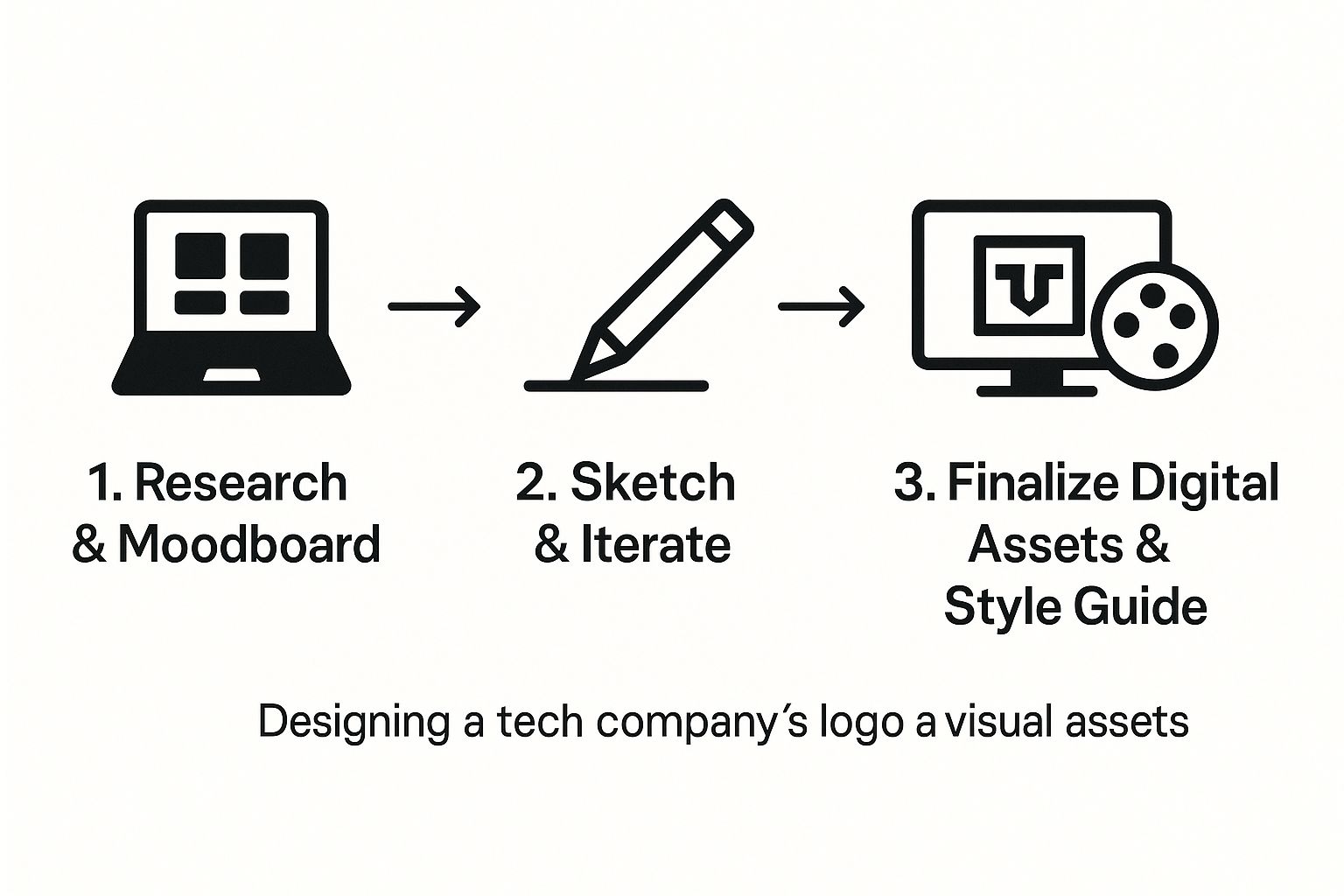Branding for Tech Companies That Inspire
July 20, 2025

Effective branding for tech companies isn't about slapping a logo on your website and calling it a day. It’s the deep, strategic work of carving out your company's identity to pull in investors, the best talent, and customers who stick around. It's how you build a movement around your product, not just a customer list.
Why Powerful Branding Is Your Greatest Asset in Tech
 In the tech world, it’s easy to get lost in the code, the features, and the product roadmap. While those things are the bedrock of your business, they don't forge an emotional connection. That's where powerful branding comes in. It’s the invisible force that builds trust long before a sales demo ever happens, turning your innovative solution from a line on a spreadsheet into something your customer can’t imagine their work without.
In the tech world, it’s easy to get lost in the code, the features, and the product roadmap. While those things are the bedrock of your business, they don't forge an emotional connection. That's where powerful branding comes in. It’s the invisible force that builds trust long before a sales demo ever happens, turning your innovative solution from a line on a spreadsheet into something your customer can’t imagine their work without.
A strong brand answers the "why" behind what you do. It gives your company a mission that people can get behind, drawing in those who believe in the future you're building. This isn't just about feel-good marketing; it's about creating a competitive moat that a rival can't cross just by shipping a new feature.
When your brand genuinely stands for something, it becomes your most valuable asset.
Turning Brand Equity Into Tangible Value
The financial impact of a well-built tech brand is staggering. In 2025, the total brand value of the world’s top 100 technology companies soared to an incredible $3.2 trillion. U.S. tech brands alone made up a massive $2.5 trillion of that, proving just how much a strategic identity is worth. Just look at Apple—its brand value climbed 11% to an astonishing $574.5 billion, showing a direct line from brand perception to financial muscle.
But this value isn't just reserved for giants like Apple. For a startup, a compelling brand story delivers on several critical fronts:
- Attracts Top-Tier Talent: The best engineers and marketers aren't just looking for a paycheck; they want to be part of a mission. A strong brand story helps you punch above your weight in the war for talent.
- Inspires Investor Confidence: VCs invest in a vision just as much as they invest in a product. A clearly defined brand signals that you understand your market and have a credible plan to lead it, which significantly lowers their perceived risk.
- Commands Premium Pricing: People pay more for brands they trust and feel connected to. This loyalty translates directly into a higher customer lifetime value and much healthier margins for you.
"A brand is not what you say it is; it's what you do. Branding isn't a project with an end date but a living, breathing commitment that drives your culture and operations forward."
The Foundation of Growth and Loyalty
Think of your brand as the operating system for your entire company. It should inform every decision you make—from product development to customer support interactions to the copy on your website. Every single touchpoint needs to feel consistent and authentic, because that's how you build the deep-seated trust required for real, long-term growth.
This is exactly why your website is at the heart of B2B marketing growth. It’s the most complete expression of your brand, and it's where prospects go to see if you're the real deal.
To truly appreciate why your brand is your greatest asset, it's worth exploring the unique intersection of brand and technology more deeply. When you invest in your brand, you're not just buying a new logo. You're investing in a resilient, enduring business that can weather market storms and build a lasting legacy.
Discovering Your Tech Brand's Authentic Core

Before a single pixel is pushed or a tagline gets drafted, the real work of branding begins. This is the introspective, often challenging, journey to uncover the very soul of your B2B tech company.
This isn't a fluffy, feel-good exercise. It's the strategic foundation that stops you from building a beautiful house on a foundation of sand. Your authentic core is your North Star—it keeps you grounded, guides every decision from product to marketing, and ensures your brand connects on a deeply human level.
The goal is to move beyond what you do and get crystal clear on why you do it. The most enduring tech brands aren't just selling software; they're selling a belief, a better way of working, or a vision for the future. Getting this right demands genuine alignment from your entire leadership team. It has to be a collaborative dig, not a top-down decree.
Defining Your Mission, Vision, and Values
This foundational trifecta is often mistaken for corporate jargon destined for a forgotten "About Us" page. When done right, however, it becomes the most powerful tool in your arsenal. It provides the clarity needed to make tough decisions and the inspiration to rally your team and your customers around a shared purpose.
Let's break them down.
Your Mission (The Why): This is your purpose. It’s the reason your company exists beyond making a profit. For a B2B SaaS company, a mission might be, "To empower small businesses to compete with enterprise giants through accessible data analytics." It’s your unchanging reason for being.
Your Vision (The Where): This is the future you are working to create. It should be ambitious and inspiring, painting a picture of the world once your mission is realized. A vision could be, "A world where every business decision is driven by insight, not intuition."
Your Values (The How): These are the non-negotiable principles that guide your behavior, both internally and with customers. Your values are your operational compass. They dictate how you build products, treat customers, and hire talent. They have to be more than just words on a wall; they must be actions.
A common pitfall is crafting values that sound good but aren’t truly lived. If you claim "customer obsession" is a core value, every single employee—from engineering to finance—must be empowered to act on it. Your brand's integrity hangs on this consistency.
From Principles to Personality
Once you've established your mission, vision, and values, the next layer is bringing them to life through a distinct personality and voice. If your brand were a person, who would it be? This is what separates memorable brands from forgettable ones. It breathes a human quality into your identity that people can actually connect with.
Think about some of the common archetypes in the tech world. Are you:
- The Trailblazer: Daring, innovative, and always pushing boundaries (think early-days Apple).
- The Mentor: Wise, guiding, and empowering (like HubSpot or Salesforce).
- The Partner: Reliable, supportive, and steadfast (like Microsoft).
Choosing a personality isn't about picking what's popular; it's about selecting one that authentically reflects your core values and speaks directly to your ideal customer. A cybersecurity firm targeting government agencies is going to have a profoundly different personality than a project management tool for creative freelancers.
This personality then directly informs your brand voice—the specific way you communicate across every single channel. Is your language formal and authoritative or witty and conversational? Is it direct and technical or simple and approachable? This voice must be consistent everywhere, from your website copy and social media posts to your sales emails and even your API documentation.
Ultimately, this entire process is about building a coherent and compelling story. It’s a story that your employees are proud to be a part of and one that your customers want to join. Seeing how established companies strategically adapt their identities can be incredibly insightful. For instance, you can learn a ton from these iconic rebranding examples and their strategies to see how refreshing a brand's core can change everything.
Designing Your Brand's Visual and Verbal Identity
Alright, you’ve done the hard work of defining your brand's core. Now for the fun part: giving it a face and a voice. This is where your strategy moves from abstract ideas on a whiteboard to the tangible things your customers will actually see and hear. We're talking about the visual and verbal systems that will show up across every single touchpoint.
This isn't just about getting a cool logo. It’s about building a consistent, scalable system that works everywhere.
A powerful visual identity does more than just look good; it telegraphs who you are in a split second. Did you know that color alone can boost brand recognition by up to 80%? That’s because you’re building an emotional connection through a deliberate system of logos, colors, and fonts that all work together.
The other side of this is your verbal identity—how your brand sounds. This is the consistent tone and language that ensures you sound like you everywhere, from a high-stakes investor deck to the tiny bit of text on a button.
Crafting a Memorable Visual System
Your visual identity is the most immediate handshake you have with the world. It’s the first thing people notice, so it needs to make a real impression. The process here is much more than just design; it's deep strategic thinking.
Start by getting your team to create moodboards that capture the feeling you want to evoke. Don't just look at other tech companies—that's a recipe for blandness. Pull inspiration from architecture, classic print design, even nature. Look for textures, color palettes, and shapes that feel right for your brand's personality. This research phase is your best defense against creating something generic and instantly forgettable.
From there, it’s all about sketching and iteration. Explore a wide range of logo concepts. Does a simple, clean wordmark best communicate your straightforward approach? Or does a more abstract symbol better capture your innovative spirit? Don’t fall in love with the first good idea. The goal is to explore widely to find the one concept that tells your story most effectively.
This is a great breakdown of how that creative process typically flows from abstract thinking to concrete assets.

As you can see, there's a clear, structured progression. It's not just random creativity; it's a methodical process that turns research into a final, polished identity system.
Building a Robust Verbal Identity
While visuals attract attention, words are what ultimately persuade. Your verbal identity, or brand voice, is how you build relationships and make your value crystal clear. It needs to be distinctive and, above all, consistent everywhere people encounter your brand.
To nail down your voice, go back to the brand personality you defined. If you’re a "Mentor" archetype, your voice should be guiding, insightful, and clear. If you’re a "Trailblazer," it might be more challenging, bold, and energetic.
A common mistake I see all the time is when a startup adopts a voice that feels completely disconnected from its team or product. If your internal culture is highly technical and direct, forcing a quirky, playful voice will just come off as fake. Authenticity is your most valuable asset here.
Once you’ve settled on a voice, it’s time to build a messaging framework. This is more than just a tagline; it's a hierarchy of your core messages that keeps everyone on the same page.
- Value Proposition: The one-sentence gut punch that explains the primary benefit you deliver.
- Key Pillars: Three or four core themes that support your value proposition. Think of these as the main chapters of your story.
- Proof Points: The specific features, customer data, or testimonials that back up your claims.
This framework becomes the single source of truth for all your marketing and communications. It's what you'll pull from for your website, sales decks, and ad campaigns. Ensuring everyone is telling the same powerful story is a non-negotiable part of any solid GTM motion. In fact, we have a whole guide on how to build a winning SaaS go-to-market strategy that dives deeper into this.
At the end of the day, your visual and verbal identities are two sides of the same coin. They must work together seamlessly to create a unified and memorable brand experience. When everything from the color of your logo to the tone of a support email feels connected, you start to build the kind of deep trust that defines market leaders.
Carving Out Your Space in a Crowded Market

Let’s be honest. A brilliant brand without a clear market position is like a race car with no steering wheel—it makes a lot of noise, but it’s going nowhere fast. You can pour your heart into creating an authentic brand core and a stunning visual identity, but if you can’t clearly articulate where you fit, you’ll be invisible to the very customers who need you most.
This is where the real work of strategic positioning begins. It’s not a fluffy marketing exercise; it’s the deliberate process of claiming a specific, valuable, and defensible spot in the minds of your audience. The goal is to shift from being “just another B2B startup” to becoming the definitive choice for a particular problem. This isn't about outspending your competitors—it's about out-thinking them.
Finding the White Space
Your first move is a clear-eyed competitive analysis. And I don’t mean just listing features. The real goal here is to find the “white space”—the unmet needs and underserved customer segments your competitors are either ignoring or just plain getting wrong. This is where you can plant your flag.
To do this right, you need to map out the landscape. Pick your top competitors and dissect them across a few critical dimensions:
- Their Core Message: What are they really selling? Is it speed? Cost savings? Security? Ease of use? Listen to the language they use on their homepage and in their ads.
- Their Target Audience: Who are they talking to? Is their messaging clearly aimed at enterprise CIOs, scrappy small business owners, or freelance developers?
- Their Brand Personality: How do they sound? Are they buttoned-up and corporate, or are they friendly, casual, and supportive?
Once you lay all this out, the gaps start to appear. Maybe everyone is chasing enterprise clients, leaving a massive opportunity for a solution built specifically for mid-market companies. Or perhaps every competitor sounds like a faceless corporation, creating a clear opening for a brand with a more human, relatable voice. That’s your entry point.
Crafting Your Positioning Statement
With a clear view of the white space, you can now build your positioning statement. Think of this as an internal document—your brand's elevator pitch to itself. It’s the compass that keeps every piece of marketing, every sales call, and every product decision pointing in the same direction.
A powerful positioning statement nails four key elements:
- For (Target Customer): Who, specifically, are you serving? Get granular. "B2B companies" isn't enough.
- Who Has (The Problem): What is the acute pain point you're solving for them?
- Our Product Is A (Market Category): How should they mentally categorize your solution?
- That Provides (Key Benefit): What is the unique value you deliver that no one else can?
For example, a fintech startup might land on this: "For B2B SaaS founders struggling with complex revenue recognition, our platform is an automated accounting solution that provides audit-proof compliance, saving them hundreds of hours per year."
This simple statement is your strategic anchor. It stops you from falling into the classic startup trap of trying to be everything to everyone. Getting this foundation right is non-negotiable, which is why our guide on strategic B2B SaaS positioning offers a much deeper roadmap for building it out.
A Masterclass in Repositioning from NVIDIA
If you want to see the power of positioning in action, look no further than NVIDIA. For years, they were known almost exclusively by gamers for their high-end graphics cards. But the company brilliantly saw a massive technological shift on the horizon and repositioned itself at the very center of the AI revolution.
NVIDIA’s strategic pivot shows what’s possible when you see where the world is going and claim that future as your own. This move wasn't just a small win; it led to a staggering 98% surge in its brand value to $87.9 billion, launching it into the global top 10 most valuable brands for the first time. You can see the full breakdown of this incredible brand growth on brandfinance.com.
By owning the "AI hardware" category, NVIDIA didn't just find white space—it created an entirely new market that it now dominates. Your own journey in branding for tech companies is to find your version of this strategic clarity.
How to Launch and Live Your Brand Every Day
Your brand isn't a project with a neat little launch date. It’s a living, breathing thing that needs to be nurtured every single day. The difference between a company that just exists and one that matters is that commitment.
A brand isn't what you declare in a press release—it's what you do, day in and day out. This is where your strategy becomes your culture, and your culture becomes your most powerful marketing asset. The most compelling branding for tech companies is demonstrated, not just announced.
This final, critical phase is all about weaving your brand into the company's DNA. It starts with your own people—the ones building the product and talking to customers. Only when they're on board can you take it to the world with real confidence and authenticity.
Ignite Your Brand from Within
An external brand launch that your own team doesn’t believe in is dead on arrival. Your employees need to be your first and most passionate champions. Forget sending a memo with the new logo. An internal launch should be an event that builds real excitement and deep understanding.
Make it an experience. Walk them through the entire journey—the workshops, the messy debates, the "aha" moments that led to this new identity. Show them exactly how the mission, vision, and values connect to the new logo, the new tagline, and the way you talk.
Give them the tools to be great ambassadors:
- A Detailed Brand Book: This is their bible for using the brand correctly. It needs to cover everything from logo usage and color codes to the right tone of voice for a support ticket.
- Ready-to-Use Templates: Make it easy for them. Provide updated slide decks, email signatures, and document templates so the new brand is the path of least resistance.
- Clear Messaging Guidelines: Arm them with the core value proposition and key talking points. When everyone tells the same powerful story, it sticks.
When your team feels like they were part of the brand’s creation, they will own it. That internal energy is infectious, and it will naturally spill over into every single customer interaction.
Orchestrate Your External Debut
Once your internal champions are fired up, it’s time to tell the world. Your external launch shouldn't be a slow trickle of updates; it needs to be a coordinated, high-impact event. The goal is to make a statement and ensure your story is heard consistently across every channel at once.
Your website is the star of the show—it's the most complete expression of your brand. But a great launch is a multi-channel effort.
Your content is the engine that will carry your new brand story far and wide. This is where you can really unpack your point of view and prove your value. An effective B2B content marketing strategy to drive conversions is non-negotiable here; it turns your brand message into a machine that generates real leads.
Beyond content, make sure your new brand goes live everywhere, simultaneously:
- Social Media: Update every profile, banner, and bio. Use the launch to re-introduce your company and what you stand for.
- Public Relations: A well-crafted press release can amplify your story and give it valuable third-party credibility.
- Partner Communications: Give your partners a heads-up so they can support the launch and update any co-branded materials.
A critical mistake is to treat the launch as the finish line. In reality, it's the starting gun. Your brand only becomes real when you live it consistently over time.
The Ongoing Discipline of Brand Stewardship
Branding isn't a "set it and forget it" task. It’s a project that never truly ends. The market will shift, your product will evolve, and your customers’ needs will change. Great brand stewardship means listening, measuring, and evolving gracefully without losing your soul.
Check in on your brand's health regularly. Use tools to monitor social media sentiment and keep an eye on what people are saying about you on review sites and in forums. More importantly, actually talk to your customers. Are you living up to the promise you made at launch?
This constant feedback loop is what allows you to make smart adjustments, ensuring your brand stays relevant and resonant. It’s a daily commitment to being the company you said you were—a practice that builds the deep, unshakable trust that defines true market leaders.
Even with the best roadmap, building a standout tech brand is never a straight line. It’s full of tough questions and those "what if" moments that can stall your progress. Let's dig into some of the most common hurdles I see founders and marketers run into.
Think of this as a set of guiding principles from the trenches—straightforward answers to help you navigate the tricky decisions that will shape your company's identity and, ultimately, its future.
When Is the Right Time for a Startup to Focus on Branding?
The short answer? Day one. But hold on—that doesn’t mean you need a polished logo and a flashy brand launch before you’ve written a single line of code. It’s all about phasing it correctly.
Your foundational branding—the mission, vision, and core values—needs to be there from the very beginning. These aren't just fluffy statements; they're your strategic compass. They guide absolutely critical early decisions, from your product roadmap to the kind of talent you hire and the culture you build. This internal alignment is the bedrock of your brand.
The more visible stuff, like a comprehensive visual identity and a big public launch, can wait. A great time for that is when you’re approaching a major milestone, like closing your seed round or gearing up for your first product release.
The key is to be proactive. If you wait until you have a "branding problem," you're already in a tough spot, facing an expensive and time-consuming battle to fix confused perceptions in the market.
Branding isn't a project you start and finish; it's a practice you adopt. Starting early, even with just the basics, builds a strong foundation. It saves you from making difficult, expensive corrections down the road when you’re trying to scale.
How Do You Measure the ROI of Branding for a Tech Company?
Measuring the return on your branding investment can feel a bit like nailing jelly to a wall, but it's entirely possible if you look at a mix of qualitative and quantitative signals. It’s never just one number on a dashboard; it’s a collection of indicators that show your brand is gaining real traction and influence.
On the quantitative side, you can track several hard metrics:
- Branded Search Volume: Are more people searching directly for your company name? Tools like Google Trends or Ahrefs can show you this. It's a powerful signal of growing awareness.
- Direct Website Traffic: An increase in users typing your URL directly into their browser means your brand is becoming a destination, not just a random click from a search query.
- Lead Quality: A strong brand acts as a filter, attracting better-fit customers. Keep an eye on whether your inbound leads are getting closer to your ideal customer profile over time.
Qualitatively, the signs are just as critical. Keep tabs on brand sentiment on social media, industry forums, and review sites. Are people talking about you in a positive light? Are you earning press mentions without paying for them?
And here’s a big one I always look for: check out the caliber of talent applying for your open roles. When top-tier engineers and marketers are actively seeking you out, you know your brand is doing heavy lifting.
Ultimately, a powerful brand should directly impact your core business metrics. It should lower your Customer Acquisition Cost (CAC) because you're relying less on expensive paid channels and more on your reputation. It should also increase your Customer Lifetime Value (LTV) as you build loyalty and command better pricing.
Should Our Tech Brand Be Serious or More Approachable?
This is a fantastic question, and the answer depends entirely on two things: your target audience and the problem your technology solves. There is no single "right" tone for branding for tech companies. The only rule is to be authentic.
Think about it. A cybersecurity firm selling complex threat intelligence solutions to CISOs at Fortune 500 companies will naturally do better with a professional, authoritative, and deeply trustworthy brand personality. Their audience is making incredibly high-stakes decisions and needs to feel rock-solid confidence in their choice.
On the flip side, a collaboration app built for creative freelancers could thrive with a personality that’s fun, witty, and super relatable. That approach builds a sense of community and makes the tool feel more like a partner in their work than just another piece of software.
The biggest mistake you can make is faking it. If your team is genuinely direct and engineering-driven, trying to force a quirky, playful voice will just ring hollow. Align your brand’s tone with your company's real values and, most importantly, with the expectations of the people you want to serve.
At the end of the day, B2B buyers want simple choices, and a clear, authentic brand personality makes their decision much easier by signaling exactly who you are and what you stand for.
Ready to stop guessing and start building a B2B tech brand that drives real growth? Big Moves Marketing provides the fractional CMO expertise to build a clear brand, nail your positioning, and execute campaigns that deliver results. Get your clear roadmap to scale.
%20-%20Alternate.svg)


%20-%20white.svg)